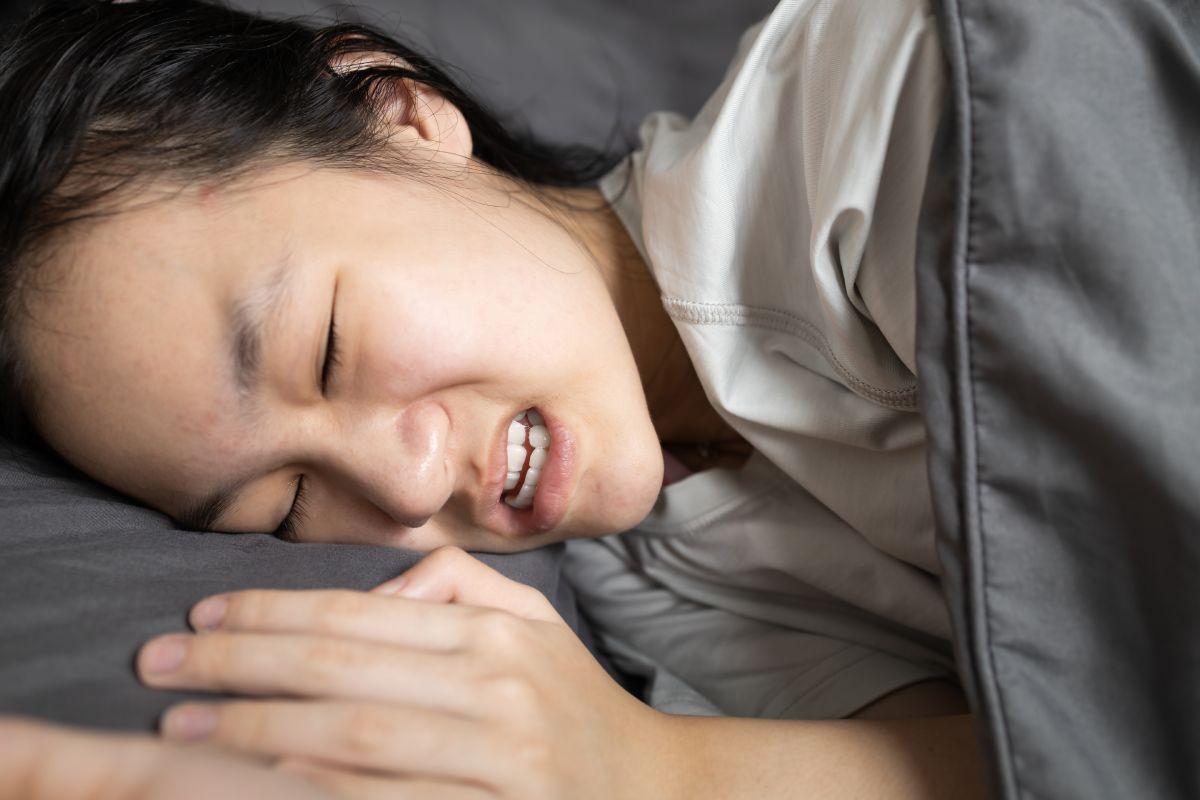Maria had been struggling with poor sleep for months. She’d wake up feeling exhausted, often with a sore jaw and headaches that seemed to linger throughout the day. After trying everything from new pillows to sleep aids with little success, her dentist made an observation that changed everything: “Have you considered that your jaw position might be affecting your sleep?”
What Maria discovered opened her eyes to a connection she never knew existed – the intricate relationship between jaw position, temporomandibular joint (TMJ) health, bite alignment, and sleep quality. This connection affects millions of people, yet many remain unaware that their jaw could be the key to better sleep and overall health.
Understanding the Jaw-Sleep Connection
The relationship between jaw position and sleep quality is more complex and significant than most people realize. Your temporomandibular joints (TMJ) – the hinges that connect your lower jaw to your skull – play a crucial role not just in eating and speaking, but also in how well you sleep at night.
When your jaw is properly positioned and your TMJ joints are healthy, your airway remains open and unobstructed during sleep. However, when there are problems with jaw alignment, bite issues, or TMJ disorders, these can directly impact your ability to breathe properly during sleep, leading to a cascade of sleep-related problems.
Research shows that patients with sleep-disordered breathing, such as obstructive sleep apnea, often have their jaw joints positioned further back than normal, creating smaller airway volumes¹. This posterior positioning can contribute to both breathing difficulties and jaw problems, creating a cycle where poor sleep affects jaw health, and jaw problems worsen sleep quality.
The Bidirectional Relationship: Pain and Sleep
One of the most striking aspects of the jaw-sleep connection is how problems in one area can amplify issues in the other. If you suffer from TMJ disorders and experience jaw pain, you’re likely to have poorer sleep quality. Conversely, if you consistently get poor sleep, you may find that your jaw pain and dysfunction actually get worse².
This creates what healthcare professionals call a bidirectional relationship – a cycle where each problem feeds into the other. Patients with TMJ disorders who experience excessive daytime sleepiness often report greater jaw pain and reduced jaw function³. The pain makes it difficult to fall asleep and stay asleep, while the resulting sleep deprivation makes the body more sensitive to pain and less able to heal and recover.
Common Signs of the Jaw-Sleep Connection
Many people experience symptoms related to this connection without realizing the underlying cause:
- Waking up with jaw pain or stiffness that gradually improves throughout the day
- Grinding or clenching teeth during sleep (bruxism) that leaves jaw muscles sore
- Frequent headaches, especially in the morning that may be related to jaw tension
- Feeling tired despite getting adequate hours of sleep due to poor sleep quality
- Difficulty opening your mouth fully in the morning before the jaw “loosens up”
How Bite Alignment Affects Your Sleep
Your bite – the way your upper and lower teeth come together – plays a crucial role in both jaw health and sleep quality. Certain bite patterns are more likely to contribute to TMJ problems and sleep-disordered breathing.
Deep Overbites and Posterior Positioning: When your upper teeth significantly overlap your lower teeth, this can push your lower jaw into a more posterior (backward) position. This positioning can narrow your airway and increase the likelihood of breathing problems during sleep⁴.
Open Bites and Airway Issues: Patients with anterior open bites (where the front teeth don’t touch when biting down) have a higher risk of developing condylar resorption and may also experience airway challenges that affect sleep quality⁵.
Crossbites and Dysfunction: When your upper and lower teeth don’t align properly from side to side, this can lead to TMJ dysfunction and may also be linked to broader musculoskeletal issues that affect sleep posture and comfort⁶.
The connection between bite alignment and sleep isn’t always immediately obvious. You might have lived with a particular bite pattern your entire life without realizing it could be contributing to sleep problems. However, when bite issues are combined with other factors like stress, aging, or hormonal changes, they can begin to significantly impact both jaw health and sleep quality.
Treatment Options: Addressing Both Issues Together
The good news is that understanding the connection between jaw position and sleep quality opens up new treatment possibilities. Rather than treating sleep problems and jaw issues separately, a comprehensive approach often yields better results.
Oral Appliances for Sleep Disorders
Mandibular advancement devices (MADs) are increasingly used to treat obstructive sleep apnea by gently positioning the lower jaw forward during sleep. This forward positioning helps keep the airway open and can significantly improve breathing and sleep quality.
While some patients initially worry about potential jaw discomfort from these devices, research shows that most people adapt well to them. Any initial jaw discomfort is typically mild and temporary, and the vast majority of patients don’t discontinue therapy due to jaw issues⁷. In fact, many patients find that better sleep quality actually helps reduce overall jaw tension and pain.
Bite Splints and Night Guards
For patients whose sleep problems are primarily related to grinding or clenching, custom bite splints can provide significant relief. These appliances protect the teeth from wear while also helping to position the jaw in a more optimal position for both comfort and airway function.
Modern bite splints are designed not just to protect teeth, but to optimize jaw position for better breathing and reduced muscle tension. When properly designed and fitted, they can address multiple issues simultaneously: protecting teeth from grinding damage, reducing jaw muscle tension, and potentially improving airway function during sleep⁸.
Orthodontic Intervention
In some cases, orthodontic treatment can address underlying bite problems that contribute to both TMJ issues and sleep-disordered breathing. This might involve expanding the upper jaw to create more space for the tongue and improve nasal breathing, or correcting bite relationships that put excessive strain on the jaw joints.
The timing and type of orthodontic intervention depends on many factors, including age, the severity of bite problems, and the presence of growth potential. In growing children and adolescents, early intervention can often address developing problems before they become more serious issues affecting both jaw health and sleep quality.
When to Seek Professional Help
Given the complex relationship between jaw position and sleep quality, it’s important to know when to seek professional help. Consider consulting with healthcare professionals if you experience:
- Persistent jaw pain or stiffness, especially upon waking
- Chronic sleep problems that don’t improve with typical sleep hygiene measures
- Frequent morning headaches that seem related to jaw tension
- Loud snoring or breathing disruptions during sleep
- Excessive daytime fatigue despite adequate sleep time
- Changes in your bite or how your teeth fit together
The Importance of a Team Approach
Effectively addressing the connection between jaw position and sleep quality often requires collaboration between different healthcare professionals. Your general dentist might be the first to notice signs of grinding or jaw problems. An orthodontist can evaluate bite relationships and jaw development. A sleep medicine specialist can conduct sleep studies and diagnose sleep disorders. A TMJ specialist can address complex jaw joint problems.
This team approach ensures that all aspects of the jaw-sleep connection are properly evaluated and treated. What might seem like separate problems – poor sleep and jaw pain – are often interconnected issues that benefit from coordinated care.
The Role of Lifestyle Factors
While professional treatment is often necessary for significant jaw and sleep problems, certain lifestyle modifications can also help improve the jaw-sleep connection:
Stress Management: Since stress often contributes to both jaw clenching and sleep problems, stress reduction techniques like meditation, yoga, or regular exercise can benefit both areas.
Sleep Positioning: Sleeping on your back with proper pillow support can help maintain better jaw and airway alignment during sleep.
Avoiding Hard Foods Before Bed: Giving your jaw muscles time to relax before sleep by avoiding hard or chewy foods in the evening can reduce nighttime tension.
Creating a Relaxing Bedtime Routine: Activities that help both your mind and jaw muscles relax can improve overall sleep quality.
Looking Toward Better Health
Understanding the connection between jaw position and sleep quality represents an important step toward better overall health. When we recognize that jaw problems and sleep issues are often interconnected, we can pursue more effective, comprehensive treatment approaches.
For Maria, learning about this connection led to treatment that addressed both her TMJ disorder and her sleep problems. With a custom oral appliance and some lifestyle modifications, she began sleeping better and waking up without jaw pain for the first time in months. Her story illustrates how addressing the jaw-sleep connection can dramatically improve quality of life.
The Bottom Line
Your jaw position and sleep quality are more connected than you might think. Jaw problems can worsen sleep, poor sleep can increase jaw pain and dysfunction, and certain bite patterns can contribute to both issues. The key is recognizing these connections and seeking appropriate professional help when needed.
If you’re struggling with sleep problems, jaw pain, or both, don’t assume they’re separate issues. A comprehensive evaluation that considers the jaw-sleep connection could be the key to finding effective solutions and achieving better overall health and well-being.
Remember, good sleep isn’t a luxury – it’s essential for your health. And if your jaw position is affecting your sleep quality, addressing that connection could be one of the most important steps you take toward better health and a better quality of life.
References
- Truong, L., Reher, P., & Doan, N. (2020). Correlation between upper airway dimension and TMJ position in patients with sleep disordered breathing. CRANIO®, 41, 331-339. https://doi.org/10.1080/08869634.2020.1853465
- Dreweck, F., Soares, S., Duarte, J., Conti, P., De Luca Canto, G., & Porporatti, A. (2020). Association between painful temporomandibular disorders and sleep quality: A systematic review. Journal of Oral Rehabilitation. https://doi.org/10.1111/joor.12993
- Xiong, X., Xiao, C., Yang, Y., Li, Y., Cheng, Q., Wang, X., & Liu, Y. (2023). Temporomandibular disorder patients with excessive daytime sleepiness present greater pain intensity and reduced jaw function. Journal of Oral Rehabilitation. https://doi.org/10.1111/joor.13639
- Kyrychenko, N., & Kostiuk, T. (2024). Magnetic Resonance Imaging in Patients with Deep Bite and Disorders of the Musculoskeletal Complex. SUCHASNA STOMATOLOHIYA. https://doi.org/10.33295/1992-576x-2024-6-102
- Qu, G., Bu, L., Li, X., You, Q., Luo, Y., & Yang, C. (2024). Malocclusion Associated With Temporomandibular Joint Anterior Disc Displacement and Condylar Resorption in Adolescents: A Cross-Sectional Study. Journal of Oral Rehabilitation. https://doi.org/10.1111/joor.13924
- Smaglyuk, L., Karasiunok, A., Kulish, N., Liakhovska, A., Voronkova, H., Bilous, A., & Smaglyuk, V. (2024). Optimization of the clinical diagnostic examination algorithm of patients with a cross bite complicated by cranio-mandibular dysfunction and postural disorder. Polski Merkuriusz Lekarski, 52(2), 203-207. https://doi.org/10.36740/Merkur202402109
- Langaliya, A., Alam, M., Hegde, U., Panakaje, M., Cervino, G., & Minervini, G. (2023). Occurrence of Temporomandibular Disorders among patients undergoing treatment for Obstructive Sleep Apnoea Syndrome (OSAS) using Mandibular Advancement Device (MAD): A Systematic Review conducted according to PRISMA guidelines and the Cochrane handbook for systematic reviews of interventions. Journal of Oral Rehabilitation. https://doi.org/10.1111/joor.13574
- Zhu, Y., Zheng, F., Gong, Y., Yin, D., & Liu, Y. (2024). Biomechanical behavior of customized splint for the patient with temporomandibular disorders: A three-dimensional finite element analysis. Biocybernetics and Biomedical Engineering. https://doi.org/10.1016/j.bbe.2023.12.007





